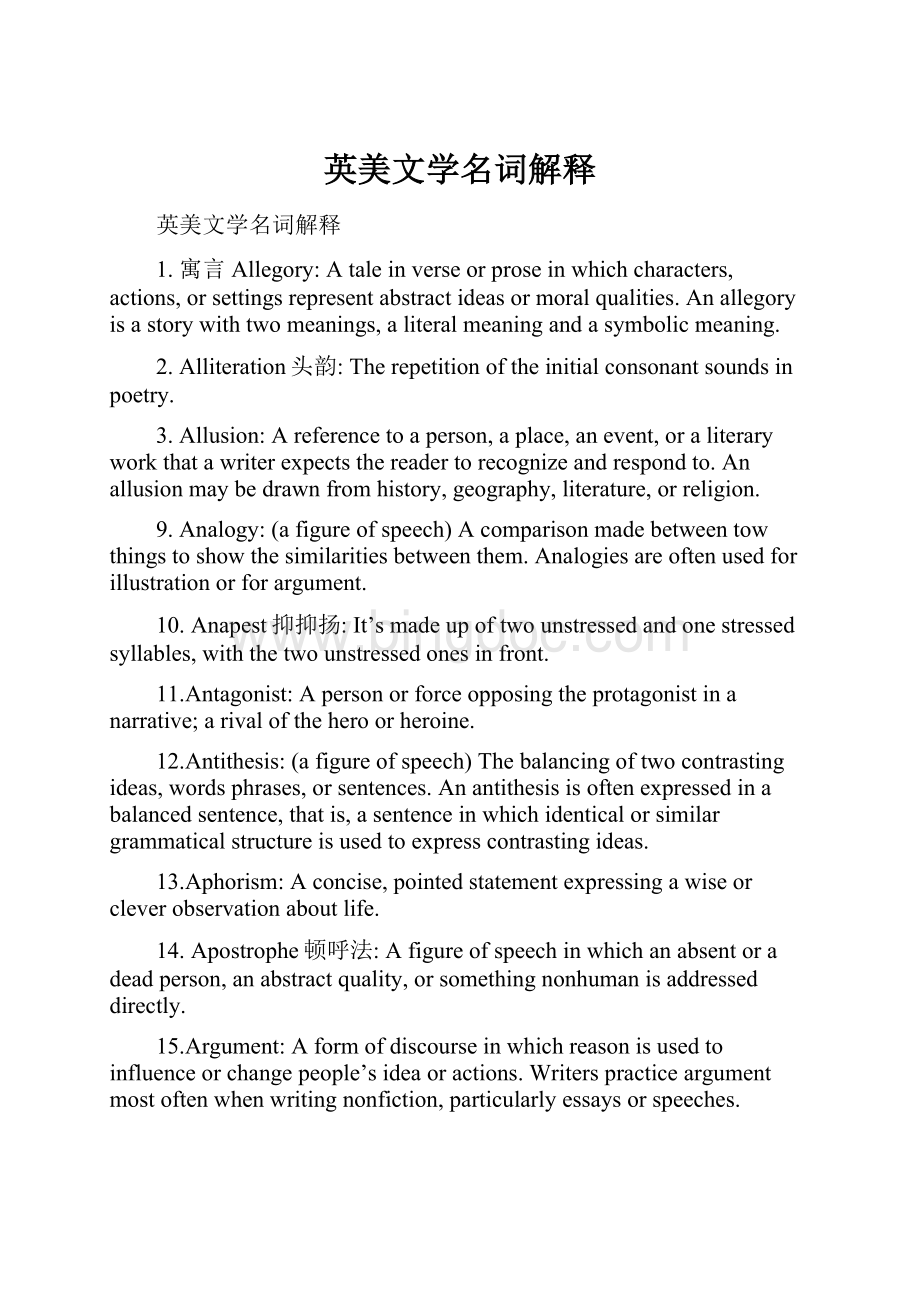英美文学名词解释.docx
《英美文学名词解释.docx》由会员分享,可在线阅读,更多相关《英美文学名词解释.docx(17页珍藏版)》请在冰点文库上搜索。

英美文学名词解释
英美文学名词解释
1.寓言Allegory:
Ataleinverseorproseinwhichcharacters,actions,orsettingsrepresentabstractideasormoralqualities.Anallegoryisastorywithtwomeanings,aliteralmeaningandasymbolicmeaning.
2.Alliteration头韵:
Therepetitionoftheinitialconsonantsoundsinpoetry.
3.Allusion:
Areferencetoaperson,aplace,anevent,oraliteraryworkthatawriterexpectsthereadertorecognizeandrespondto.Anallusionmaybedrawnfromhistory,geography,literature,orreligion.
9.Analogy:
(afigureofspeech)Acomparisonmadebetweentowthingstoshowthesimilaritiesbetweenthem.Analogiesareoftenusedforillustrationorforargument.
10.Anapest抑抑扬:
It’smadeupoftwounstressedandonestressedsyllables,withthetwounstressedonesinfront.
11.Antagonist:
Apersonorforceopposingtheprotagonistinanarrative;arivaloftheheroorheroine.
12.Antithesis:
(afigureofspeech)Thebalancingoftwocontrastingideas,wordsphrases,orsentences.Anantithesisisoftenexpressedinabalancedsentence,thatis,asentenceinwhichidenticalorsimilargrammaticalstructureisusedtoexpresscontrastingideas.
13.Aphorism:
Aconcise,pointedstatementexpressingawiseorcleverobservationaboutlife.
14.Apostrophe顿呼法:
Afigureofspeechinwhichanabsentoradeadperson,anabstractquality,orsomethingnonhumanisaddresseddirectly.
15.Argument:
Aformofdiscourseinwhichreasonisusedtoinfluenceorchangepeople’sideaoractions.Writerspracticeargumentmostoftenwhenwritingnonfiction,particularlyessaysorspeeches.
16.Aside:
Indrama,linesspokenbyacharacterinanundertoneordirectlytotheaudience.Anasideismeanttobeheardbytheothercharactersonstage.
17.Assonance:
Therepetitionofsimilarvowelsounds,especiallyinpoetry.Assonanceisoftenemployedtopleasetheearoremphasizecertainsounds.
18.Atmosphere:
Theprevailingmoodorfeelingofaliterarywork.Atmosphereisoftendeveloped,atleastinpart,throughdescriptionsofsetting.Suchdescriptionshelptocreateanemotionalclimateforthewerrorstoestablishthereader’sexpectationsandattitudes.
19.Autobiography:
Aperson’saccountofhisorherownlife.Anautobiographyisgenerallywritteninnarrativeformandincludessomeintrospection.
20.Ballad:
Astorytoldinverseandusuallymeanttobesung.Inmanycountries,thefolkballadwasoneoftheearliestformsofliterature.Folkballadshavenoknownauthors.Theyweretransmittedorallyfromgenerationtogenerationandwerenotsetdowninwritinguntilcenturiesaftertheywerefirstsung.Thesubjectmatteroffolkballadsstemsfromtheeverydaylifeofthecommonpeople.Devicescommonlyusedinballadsaretherefrain,incrementalrepetition,andcodelanguage.Alaterformofballadistheliteraryballad,whichimitatesthestyleofthefolkballad.
21.Balladstanza:
Atypeoffour-linestanza.Thefirstandthirdlineshavefourstressedwordsorsyllables;thesecondandfourthlineshavethreestresses.Balladmeterisusuallyiambic.Thenumberofunstressedsyllablesineachlinemayvary.Thesecondandfourthlinesrhyme.
22.Biography:
Adetailedaccountofaperson’slifewrittenbyanotherperson.
23.Blankverse:
Versewritteninunrhymediambicpentameter.
24.Caesura诗间休止:
Abreakorpauseinalineofpoetry.
25.Canto:
Asectionordivisionofalongpoem.
26.Caricature:
Theuseofexaggerationordistortiontomakeafigureappearcomicorridiculous.Aphysicalcharacteristic,aneccentricity,apersonalitytrait,oranactmaybeexaggerated.
27.Character:
Inappreciatingashortstory,charactersareanindispensableelement.Charactersarethepersonspresentedinadramaticornarrativework.Forstdividescharactersintotwotypes:
flatcharacter,whichispresentedwithoutmuchindividualizingdetail;androundcharacter,whichiscomplexintemperamentandmotivationandisrepresentedwithsubtleparticularity.
28.Characterizatiogogoo,themeansbywhichawriterrevealsthatpersonality.
29.Classicism:
Amovementortendencyinart,literature,ormusicthatreflectstheprinciplesmanifestedintheartofancientGreeceandRome.Classicismemphasizesthetraditionalandtheuniversal,andplacesvalueonreason,clarity,balance,andorder.Classicism,withitsconcernforreasonanduniversalthemes,istraditionallyopposedtoRomanticism,whichisconcernedwithemotionsandpersonalthemes.
30.Climax:
Thepointofgreatestintensity,interest,orsuspenseinagogotory’sturningpoint.Theactionleadingtotheclimaxandthesimultaneousincreaseoftensionintheplotareknownastherisingaction.Allactionaftertheclimaxisreferredtoasthefallingaction,orresolution.Thetermcrisisissometimesusedinterchangeablywithclimax.
31.Comedy:
ingeneral,aliteraryworkthatendshappilywithahealthy,amicablearmisticebetweentheprotagonistandsociety.
32.Conceit:
Akindofmetaphorthatmakesacomparisonbetweentwostartlinglydifferentthings.Aconceitmaybeabriefmetaphor,butitusuallyprovidestheframeworkforanentirepoem.Anespeciallyunusualandintellectualkindofconceitisthemetaphysicalconceit.
1.33.Conflict:
Astrugglebetweentwoopposingforcesorcharactersinashortstory,novel,play,ornarrativepoem.Usuallytheeventsofthestoryareallrelatedtotheconflict,andtheconflictisresolvedinsomewaybythestory’send.
34.Connotation:
Alltheemotionsandassociationsthatawordorphrasemayarouse.Connotationisdistinctfromdenotation,whichistheliteralor“dictionary”meaningofawordorphrase.
35.Consonance:
Therepetitionofsimilarconsonantsoundsinthemiddleorattheendofwords.
36.Couplet:
Twoconsecutivelinesofpoetrythatrhyme.Aheroiccoupletisaniambicpentametercouplet.
37.CriticalRealism:
Thecriticalrealismofthe19thcenturyflourishedinthefoutiesandinthebeginningoffifties.Therealistsfirstandforemostsetthemselvesthetaskofcriticizingcapitalistsocietyfromademocraticviewpointanddelineatedthecryingcontradictionsofbourgeoisreality.Buttheydidnotfindawaytoeradicatesocialevils.
38.Dactyl扬抑抑:
It’smadeupofonestressedandtwounstressedsyllables,withthestressedinfront.
39.Denotation:
Theliteralor“dictionary”meaningofaword.
40.Denouement结局:
Theoutcomeofaplot.Thedenouementisthatpartofaplay,shortstory,novel,ornarrativepoeminwhichconflictsareresolvedorunraveled,andmysteriesandsecretsconnectedwiththeplotareexplained.
41.Description:
Itisagreatpartofconversationandofalmostallwriting.Itisapartofautobiography,storytelling.Withdescription,thewritertriesterror,feel,andhearbyshowingratherthanbymerelytelling.It’sthroughtheuseofspecificdetailsandconcretelanguagethatabstractideasandhalf-formedthoughtsaremakevividlyreal.Wehaveobjectiveandsubjectivedescription.
42.Diction:
Awriter’schoiceofwords,particularlyforclarity,effectiveness,andprecision.
43.Dissonance:
Aharshordisagreeablecombinationofsounds;discord.
44.Dramaticmonologue:
Akindofnarrativepoeminwhichonecharacterspeakstooneormorelistenerswhoserepliesarenotgiveninthepoem.Theoccasionisusuallyacrucialoneinthespeaker’spersonalityaswellastheincidentthatisthesubjectofthepoem.
45.Elegy:
Apoemofmourning,usuallyoverthedeathofanindividual.Anelegyisatypeoflyricpoem,usuallyformalinlanguageandstructure,andsolemnorevenmelancholyintone.
46.Emblematicimage:
Averbalpictureorfigurewithalongtraditionofmoralorreligiousmeaningattachedtoit.
47.Enlightenment:
Withtheadventofthe18thcentury,inEngland,asinotherEuropeancountries,theresprangintolifeapublicmovementknownastheEnlightenment.TheEnlightenmentonthewhole,wasanexpressionofstruggleofthethenprogressiveclassofbourgeoisagainstfeudalism.Theegogoinequality,stagnation,prejudicesandothersurvivalsoffeudalism.Theattemptedtoplaceallbranchesofscienceattheserviceofmankindbyconnectingthemwiththeactualdeedsandrequirementsofthepeople.
48.Epic:
Alongnarrativepoemtellingaboutthedeedsofagreatheroandreflectingthevaluesofthesocietyfromwhichitoriginated.Manyepicsweredrawnfromanoraltraditionandweretransmittedbysongandrecitationbeforetheywerewrittendown.
49.Epigram:
Ashort,witty,pointedstatementoftenintheformofapoem.
50.Epigraph:
Aquotationormottoatthebeginningofachapter,book,shortstory,orpoemthatmakessomepointaboutthework.
51.Epilogue收场白:
Ashortadditionorconclusionattheendofaliterarywork.
52.Epiphany主显节:
Amomentofillumination,usuallyoccurringatorneartheendofawork.
53.Epitaph:
Aninscriptiononagravestoneorashortpoemwritteninmemoryofsomeonewhohasdied.
54.Epithet称号:
Adescriptivenameorphraseusedtocharacterizesomeoneorsomething.
55.EraofModernism:
Theyearsfrom1910to1930areoftencalledtheEraofModernism,forthereseemstohavebeeninbothEuropeandAmericaastrongawarenessofsomesortof“break”withthepast.Thenewartistssharedadesiretocapturethecomplexityofmodernlife,tofocusonthevarietyandconfusionofthe20thcenturybyreshapingandsometimesdiscardingtheideasandhabitsofthe19thcentury.TheEraofModernismwasindeedtheeraoftheNew.
56.Essay:
Apieceofprosewriting,usuallyshort,thatdealswithasubjectinalimitedwayandexpressesaparticularpointorview.Anessaymaybeseriousorhumorous,tightlyorganizedorrambling,restrainedoremotional.Thetwogeneralclassificationsofessayaretheinformalessaya